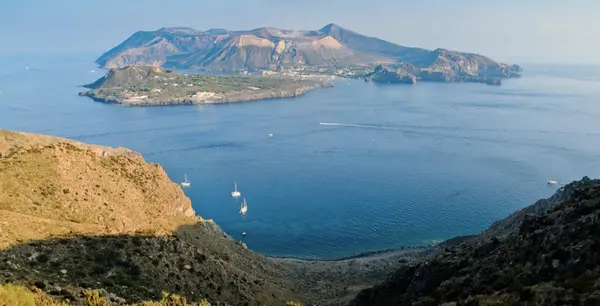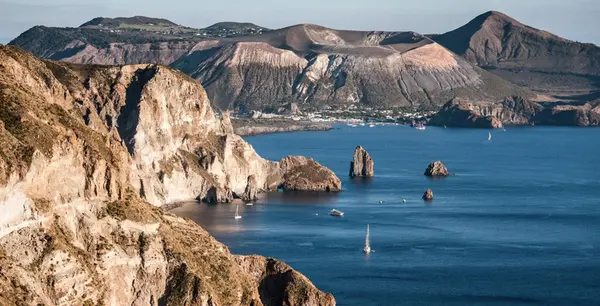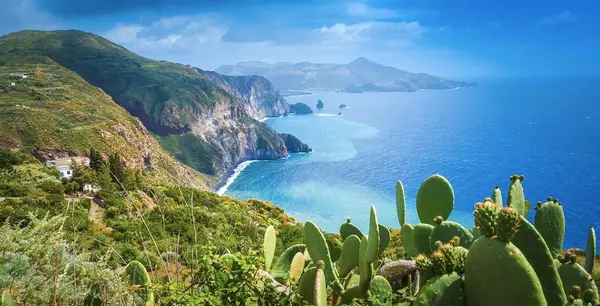The Aeolian Islands lie off Sicily at the very south of the Tyrrhenian Sea. In honour of the Roman god of winds, Aiola, they are also called the Aeolian Islands. The archipelago consists of seven larger volcanic islands and a number of smaller rocks. Where to sail now?
Why sail in the Aeolian Islands
It is indeed a very windy area with prevailing winds from the west and northwest. The combination of the stronger winds and the lack of well-protected harbours creates sailing conditions ideal for experienced sailors. Definitely not recommended for novice sailors. If the wind doesn't give you a week's rest, instead of a relaxing cruise, the holiday could turn into a nightmare. nightmare, where you don't bat an eyelid at an anchor that doesn't hold, and you can't get into the marinas because they're full in bad weather.
But enough of the scares. Yachting in the Aeolian Islands is among the most beautiful and magical in the Mediterranean. A combination of active volcanoes, mountain hikes, natural thermal baths with sulphur springs, hospitable and friendlypeople, the isolation and remoteness of some of the islands, the wildness and rawness, create an irresistibly explosive combination of captivating experiences.
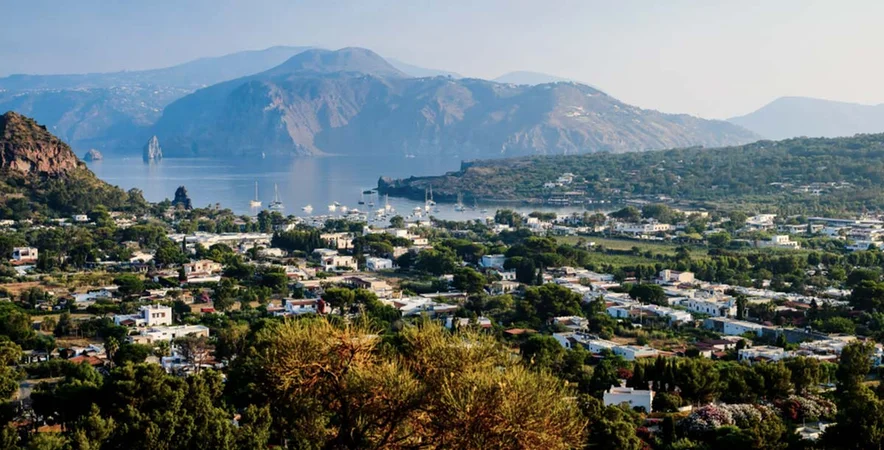
Quality of service in the Aeolian Islands
When chartering a boat in Sicily, be prepared for the fact that the Croatian standard of service is an unattainable dream for half of Sicily's charter companies. The boats are usually a little older and are reasonably well maintained. If you want to rent a new boat, you need to book long in advance and by no means put off renting at the last minute. There is a direct flight from Prague to Catania and the price is also lower if you buy well in advance.
Our Aeolian Islands cruise itinerary
Vulcano island (Gelse beach, Cape Testa Grossa in Venere bay, Vulcanella cone, Levante bay, Levante port) - Panarea island (and surrounding small islands) - Stromboli island - Salina island - Filicudi island - Alicudi island - Aeolian islands.
It is best to sail to the Aeolian Islands from Portorosa, Milazzo or the surrounding ports closest to Vulcan, the southernmost of the islands.
The first encounter with a volcano on Vulcano
The Greeks called Vulcano as Hiera Hephaistou, the sanctuary of Hephaistos. The Romans named it after their similar god Vulcano, creating a generic name for volcanoes. There is an active volcano on the island of Vulcano that will amaze you with both its beauty and the sulphurous smell emanating from the fumaroles.
On the cruise to the island, I recommend the first stop at the black beach of Gelse in the south of the island. On the beach there is a charming tavern where you can have your first drink on the Aeolian Islands and have a pleasant swim.
Turquoise lagoon
From Gelse Bay, head along the west coast to Cape Testa Grossa to Venere Bay, where there is a pretty cave and a picturesque lagoon with turquoise water. It is anchored at a fairly large depth of 18-20m, so don't leave the boat in full force, lest you find it later staying in the cave.
The many small coves on the west coast are very picturesque and well worth a visit. At the north-western tip, below the small cone of Vulcanella, is Pontente Bay with its anchorage. The entrance is marked on both sides by rock towers rising out of the sea.
If you sail around Vulcanello, you will reach the main port of Levante. There is a small seasonal pontoon marina here, which is open from 1 May to 30 September. You will pay €70 for a 15m sailboat. The marina staff are very friendly. Especially with William, an Italian Englishman, he is a real handful. He will recommend the restaurant, the sailing route, the most interesting things to see, help you to organize the service in case of any breakdown. His phone number is +39 3497587935. You can also book a place in the marina with him.
Keep an eye out for jellyfish everywhere on the islands. You can run into stinging ones quite often, so always check the immediate area around the boat before entering the water. If you do get stung by a jellyfish, it helps to rub the burned area with a sliced tomato. At least that's what the natives recommend. It also helps to urinate on the affected area, but that's not a recipe for everyone, especially if a jellyfish stings you on, say, your forehead.
How to lose your swimsuit
If you don't want to stand in the marina or there's no room, there's a mooring just north of Porto Levante that's well protected from westerly winds. You are then standing directly opposite the thermal sulphur mud pool on the shore. This shallow, about 40 cm deep muddy, hot and smelly pool is sought after for its healing properties by tourists from all over the world. To go for a dip during the day is to be part of a group experience.
I recommend going to the mud pit at night when no one is there. If you go by road, you have to climb over a low wall of stones. If you go from the sea, you just swim in. The thermal pool bubbles with hot water and some places are so hot you can't stand it. After a dip in the lake, I recommend going to the sea to rinse off and warm up some more in the thermal springs in the sea just off the beach.
The smell from the lake is so strong that you will have sulphur coming out through the pores of your skin for several days, no matter how many times you shower a day. But I definitely recommend a bath. Either go to the mud pond without a swimsuit (at night) or wear one that you won't regret having to throw away because it will almost fall apart.
Ascent of the steaming Big Crater
On the island of Vulcano, you definitely have to visit the Grand Crater, the so-called Great Crater, which is 391 meters high. The climb up is easy, but due to the heat, it's a good idea to do it in the morning or early evening.
On the northern side of the crater are the smoking fumaroles, which billow sulphurous steam and make you feel a bit like you're in hell. With a little care, you can descend to the bottom of the crater, but you have to watch the wind carefully. If the wind were to turn and smoke from the fumaroles were to start billowing into the crater, breathing would become difficult, if not impossible. Therefore, I do not recommend descending into the crater for people with reduced mobility or those suffering from anxiety.
You can also climb to the top of the crater in swimming shoes or boots (I have seen female hikers on top of the crater), but it is much more comfortable to wear hiking boots or sturdy sneakers. The view of the sunset from the Grand Crater is an unforgettable experience.
Set sail from Vulcano early in the morning and stop at the island of Panarea. Grab a coffee and then take a stroll around the picturesque town, popular with bohemians and artists. The atmosphere is sure to win you over, unless it's 40 degrees in the shade.
Better then to anchor off one of the small islands around Panarea, such as Dattilo, Panarelli or Lisca Bianca. The crystal clear water invites diving and snorkelling on the reefs, as well as fishing. You can also dive to one of the many wrecks found on the benches around Panarea. The dive bases on the island are well equipped and the clear water makes diving at the wrecks really great.
Discovering the magic of an active volcano
Anchoring on Stromboli is difficult and can more or less only be done in the shallows towards the Strombolicchino reef in the northeast of the island. On Stromboli, the locals are literally sitting on a powder keg. Sometimes they are evacuated when a particularly strong eruption is expected, and otherwise they take advantage of the fact that this hilarious active volcano attracts clouds of people to spend money here. The town of S. Vincenzo is built on a steep hillside and has streets so narrow that only a motorised tricycle can pass through them.
If you want to go up Stromboli, be prepared to climb to 900m above sea level. The best time to hike is 3 hours before sunset. It is not allowed to go up the volcano individually, only with a local guide. The price for the climb is 28 EUR/person and you can also rent shoes, poles or a headlamp. The rented material is extra.
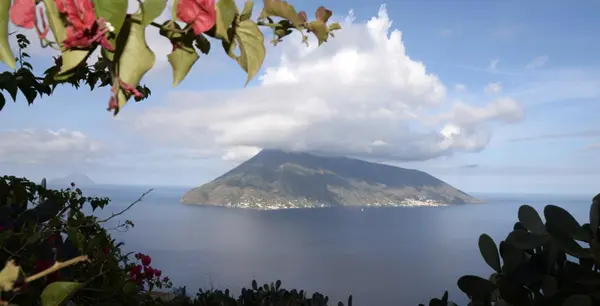
The climb up the volcano is an amazing experience and the sunset from the top is too. After dark, the glow of the volcano becomes visible and the individual eruptions, which have been going on for several thousand years approximately every 15 to 20 minutes, paint a fiery geyser in the sky. The strength of the fire geyser depends on the current volcanic activity. You go back down after dark.
If you want to go to Stromboli without a guide, it is illegal and at your own risk. You have to choose a different route than everyone else goes, the best way is to take it from the town almost straight up. In case you get a bit lost (which happens quite often, especially when returning by the shortest route), I recommend wearing long pants, because if you get into the vegetation off the path, you will be scratched to a bloody pulp. The illegal climb up the volcano also has its charms. However, it's always a good idea to check at the bottom to see how far you can go so that it doesn't happen to be your last trip.
Make sure to bring sturdy shoes, water and a windbreaker for the return trip, or a breathing mask if you want to stick your nose in the crater just when the dust and rocks are spitting. After returning from the volcano, you can stay at anchor until morning and watch your anchor to see when you break free (I've broken free of anchor here almost every time, unless it's been completely windless) or go for a romantic night cruise.
A place of extraordinary fire experiences
Circumnavigate Stromboli from the north and stop for half an hour at the northwest end, where the crater is at its lowest and where you can watch individual eruptions at night. If you manage to experience lava flowing out of the crater into the sea, which is rare, you'll have the experience of a lifetime. But even when the lava isn't flowing, the sight of the repeated eruptions turning the top of the volcano into a fiery cloud is amazing.
Not everyone wants to trudge sweaty up the hill to enjoy the volcanic eruptions. If you're one of those people and you have enough money, you can hire a helicopter to fly you to the heliport next to the harbour, take you up to Stromboli Crater and fly you over all the main islands. And all this for only 2,500 euros for 40 min. It's a bit different, but a very powerful experience.
Small islands like old times
Stretch your night cruise to the island of Salina, where you can land in the port of Santa Maria, providing all the yachting facilities. Here you pay EUR 80 for a 15 m sailboat. Salina already impresses from afar with two volcanic cones towering 962 m high. Both volcanoes are no longer active, so their cones are green and fertile.
If you like hiking in the interior, I recommend Salina. The day's trek takes you from the port of St. Maria to the summit of the higher mountain Monte Fossa, and you'll finish the hike in the town of Malfa, where you'll return by bus to the port. The next trek takes you from Malfa to the lower peak of Monte del Porri, 857 m high. From the summit you can then descend to the village of Pollara, which exudes tranquillity and seclusion from the outside world even today.
A breathtaking beach full of magical scenery
Below Pollara is a small, magical beach. This place is a must-visit. Even though you know that something extraordinary awaits you there, its beauty will still take your breath away. The pyre-like shapes of the rocks above the sea, the rock gate, the turquoise colour of the sea and the beach on the rock. You can also anchor there in calm weather, which I recommend to anyone who doesn't share my enthusiasm for all kinds of hikes.
Salina on a scooter in the Italian way
Or you can rent road scooters in Santa Maria for €30 and drive here on the good island roads. Be careful on the scooters. It's a small bike, but it's not to be underestimated. The motorbike hire company has no breakdown insurance (it only has compulsory insurance) and any damage you cause to the scooters will go to you. The rental contract is only in Italian, so no one will read it. And then they will ask you to pay for any damage.
They say that you can get accident insurance for the bike, but they won't offer it up front, and when I asked them afterwards how much the insurance costs, they couldn't tell me. So it remained a mystery to me. Despite this minor complication, I can highly recommend renting scooters. The ride around the island is definitely worth it.
The atmosphere of the old days
From Salina, head west to the island of Fillicudi, where I recommend the port of Pecorini. If you're lucky, you'll fit on the short pier (bow to anchor and stern to pier), or you'll have to drop anchor west of the pier. You can also anchor east of the pier and tie your stern to the rocks with a rope. The port of Pecorini is the least affected by tourism in the Aeolian Islands and you will enjoy the most authentic atmosphere of the old days.
Continue sailing west along the southern coast to the Blue Marino cave and from this cave head to the rock phallus that rises steeply out of the sea to a height of 70 metres. They say the fishing is good here, but we didn't have any luck. Maybe it was a lack of patience, or maybe there is no point in fishing at midday. But the view of the rock rising from the sea is very impressive.
And finally, to where time stood still
From Fillicudi you can head west towards Alicudi, the most remote of the Aeolian Islands. Tourism has hardly hit this island yet. There are no roads and no cars. The only means of transport are donkeys. On Alicudi you can enjoy the original atmosphere of seclusion and also take a trip to the 675 m high extinct volcano Filo dell'Arpa or the String of the Harp. I recommend Alicudi to all lovers of remote places without tourists.
Lipari
From Alicudi, sail eastwards to the island of Lipari, the administrative centre of the entire archipelago. It's where most of the population lives, the best place to shop and enjoy the nightlife and tourism if you crave it.
Probably the most convenient place to land is the marina of La Buona Fonda, located next to the ferry port and only a few minutes walk to the old town. There are no toilets or bathrooms in the marina, but they do have wifi. You'll pay €60 for a 15m sailboat to stand here. The marina gets pretty hectic with ferries coming in all night.
If you want a quieter place, choose one of the other marinas towards the city. The old town and citadel above the harbour breathe history and tell the story of the island's former importance and wealth. The island has been mining high quality volcanic pumice (for several thousand years) and obsidian.
If you are lucky you will encounter dolphins in the Aeolian Islands, if you are luckier you will see sea turtles and once we met a sperm whale west of Stromboli.
When to set sail?
The best time to sail in the Aeolian Islands is specific and depends on your requirements. Spring during April, May and June is the least windy time of the year, July and August are crazy crowded with tourists, September and October the sea is still pleasantly warm and it blows nicely, sometimes too much. November is windy, still warm and almost no tourists anymore. But the day is already very short.
Did we entice you? Will you take up the challenge of the god of winds and try to break free from your anchor? Choose the right boat for your adventure and you're ready to go. We'll be happy to advise you.
